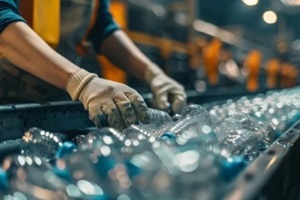October 20, 2025

An innovation in adhesive technology may offer a practical solution to one of the plastics recycling industry’s persistent challenges. A team at the University of Reading has created a polymer adhesive that stays secure during use but dissolves in alkaline solutions, making it easy to remove labels from plastics.
This development could substantially improve the quality of recycled plastic and reduce contamination, which remains a consistent barrier to efficient materials recovery. For sectors focused on sustainable manufacturing, this advancement offers environmental and operational upside for plastic recycling.
The core advantage of the adhesive lies in its ability to break down selectively at the recycling stage. In testing, the material demonstrated a 65% reduction in adhesive strength when exposed to alkaline solutions, an important indicator of its potential utility in recycling environments.
The adhesive significantly reduces residue contamination by making it easier to remove labels from plastic bottles, containers, and films, a common factor that lowers the value and reusability of recycled plastic.
The adhesive incorporates a specialized polyurethane backbone that includes sulfonyl ethyl urethane units. These function as a chemical trigger, responding to alkaline conditions with a structural shift that weakens adhesion.
While in service, the adhesive maintains a strong bond under typical handling and environmental conditions. Its ability to function across various substrates, including plastics, glass, and aluminum, makes it broadly applicable across sectors that require durable labeling and high-volume packaging.
This technology is suited for packaging operations where label separation is necessary but often overlooked due to technical limitations.
Because the adhesive remains stable during use and only dissolves during plastic recycling, it can be applied in industries with tight packaging specifications.
Food and beverage packaging stands to benefit immediately. In these markets, consumer-facing products demand reliable adhesion for branding and safety information, yet often experience increasing pressure to meet recyclability standards. The adhesive’s dissolvable properties can help producers meet both requirements.
In the electronics and logistics sectors, durable adhesives are used to secure tracking labels and compliance documentation. The new polymer has been tested for performance under varying temperatures and surface types, demonstrating suitability for electronics casings, component packaging, and shipping containers.

Laboratory testing has validated the adhesive’s strength and consistency under a spectrum of broad usage conditions. It performed comparably to commercial adhesives when tested on multiple substrates, maintaining bond strength through varying thermal exposures.
At elevated temperatures and high-humidity environments, the adhesive sustained consistent adhesion, which is essential for sectors with demanding supply chains.
For manufacturers and converters, adopting this adhesive technology is operationally manageable. Existing application methods, such as roll-on and spray systems, are compatible with the new formulation. Packaging lines would require minimal adjustment.
However, plastic recycling facilities may need to standardize pre-processing stages to introduce an alkaline wash step or modify water chemistry in existing processes. This minor process update could substantially increase the yield of clean, recyclable plastic.
Cleaner plastic recycling inputs lead to higher-quality outputs. Contamination from traditional label adhesives has long contributed to material loss and lower-grade recycled resins.
The dissolvable adhesive addresses this directly by allowing complete label removal, increasing recyclable material recovered from post-consumer packaging. Over time, this contributes to cost savings by improving processing efficiency and decreasing reliance on downstream sorting and cleaning stages.
Importantly, this technology supports continued use of virgin resin where required, while enhancing the overall recyclability of plastic products. The innovation does not force a tradeoff but rather augments circularity without disrupting current material streams.
Reliable performance remains a top concern in packaging operations, particularly in regulated industries. The adhesive’s composition has been tested for durability under commercial storage and transportation conditions, and results indicate strong performance under heat, cold, and moisture exposure.
Regarding safety and regulatory alignment, the adhesive meets standard benchmarks for chemical stability and environmental exposure. Its components were developed with compliance in mind, particularly for food and electronics applications, where chemical migration and toxicity are tightly regulated.
This adhesive can be phased in across packaging product lines over months, depending on production schedules and existing supplier relationships. Companies evaluating adoption should consider the upfront benefit of reducing future contamination risks and enhancing downstream recyclability.
Access to technical support from development partners and packaging associations can help ease the transition, especially for operations that manage complex product portfolios.

Adhesive contamination has long prevented high-quality plastic recycling. Thankfully, this innovation changes that dynamic by offering a material that performs effectively in use and simplifies clean separation during recycling. For businesses aiming to align operational goals with sustainability commitments, adopting such advances can unlock long-term value.
To stay informed on the latest breakthroughs in sustainable plastics innovations, consider joining PLASTICS, the Plastics Industry Association. Membership provides updates on the latest cutting-edge developments, access to recycling programs and information, and the opportunity to drive positive change within the industry.
PLASTICS and the Future Leaders in Plastics (FLiP) Committee are devoted to supporting and encouraging the next generation of plastics leaders who will play a crucial role in the innovation, technology and future of the plastics industry. FLiP’s mission is to provide young professionals under the age of 40 the exposure, education and resources they need to build lifelong careers in plastics. Want to join? Want to get your employees involved? Email: [email protected]